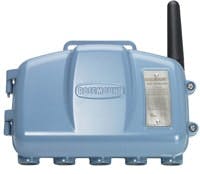Wireless Transmitter for High Density Temperature Measurement
Emerson Process Management announces the expansion of its Smart Wireless solutions with the introduction of the Rosemount 848T wireless temperature transmitter for high density temperature measurement. The 848T’s four-channel efficiency adds to installation cost-savings of Smart Wireless technology to reduce per point costs and thereby deliver more measurement data for use in improving operations and maintenance.
The 848T includes an EDD (Electronic Device Display) user interface that provides simple, graphical screens to deliver important information. The 848T wireless transmitter monitors up to four independently configurable RTD, thermocouple, ohm, millivolt and 4 – 20 mA inputs, allowing users access to more of these important temperature measurements. The resulting visibility into plant operations allows for proactive maintenance and monitoring of key assets. These include motor bearings that drive pumps, fans and compressors, as well as heat exchangers, tanks, reactors and boilers.
Fully compatible with any WirelessHART network, the Rosemount 848T temperature transmitter provides the same diagnostic data and reliable performance as other devices in the Smart Wireless family. It monitors many temperature measurements with one device, ensuring accurate and stable measurements and continuously monitors measurement integrity. The device is self-powered and utilizes SmartPower technology to provide an intrinsically safe power module with long battery life. Not only are installation costs minimized by eliminating the signal wiring, but the sensor wiring costs are reduced by being able to mount the device closer to the process.
The Rosemount 848T Wireless temperature transmitter is part of Emerson’s intelligent, digital field devices that power the PlantWeb architecture. Further cost savings, increased plant availability and enhanced safety and environmental compliance are achieved when the transmitters are integrated into the PlantWeb digital plant architecture.




